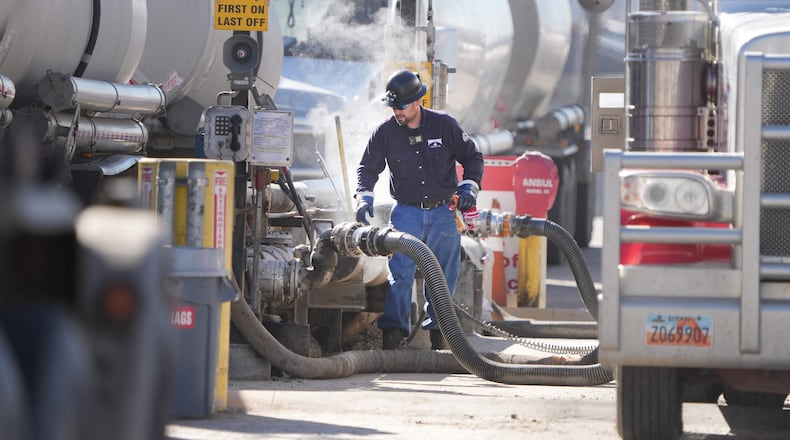Escalating military action in the waterways of the Mideast could have an impact on oil and gas prices. But experts say a sharp rise is not likely here unless the crisis grows broader and more intense.
No, we don’t get (much of) our oil from the Middle East
U.S. oil production has risen in recent years to a historical high, more than 13 million barrels per day. But we use more than 20 million barrels a day, so we still must import. (And some of what we produce is exported, partly for logistical reasons. It’s sometimes easier to ship Alaska crude to Asia than to the lower 48.)
The biggest source of imports: Canada and Mexico. Saudi Arabia is a distant third, followed by Iraq.
Still, what happens in the Strait of Hormuz doesn’t stay there
While the price of oil is set globally, about one-fifth of the world’s oil production passes through the Strait of Hormuz, a channel vulnerable to disruption by various neighbors, including Iran and the Houthi rebels in Yemen. For geopolitical and economic reasons, the U.S. has historically acted militarily to keep shipping lanes open for oil.
But any restrictions on shipments — if the channel is blockaded, or if oil must take a different route out of the region — and the price of oil rises, even oil produced elsewhere. Prices in the U.S. might not rise as much as in Europe, but oil is a global market.
The result can be increases in the price of oil products: gas, diesel and jet fuel, said Patrick DeHaan, senior petroleum analyst for Gas Buddy, which tracks fuel prices nationally. “I certainly think the situation in the last 24 hours has made things less stable than prior to that.”
When it comes to the pump, oil prices matter most
The price of oil, set by speculators buying futures, is the biggest factor in the price of gas. Most of the times that global prices spike, gas prices rise. But not always in lockstep. Since oil must be refined into fuel, Atlanta depends on a string of refineries along the Gulf Coast and into Texas that produce gas and pump it north. A refinery fire or pipeline problem can mean a shortage of gasoline and higher prices in Atlanta, even if oil itself is plentiful and cheap.
Moreover, individual station owners have some flexibility. If they sell a lot of fuel, they can charge less and get by with lower profit margins. If they have a premium location (say, the only station for miles), they can charge more.
The range is dramatic. The cheapest gas in metro Atlanta mid-day Friday was $2.59 a gallon for regular. The most expensive station was charging a buck-a-gallon more.
Yes folks, supply and demand does matter
In most years, the lowest gas prices come in the mid-winter when fewer Americans are on driving vacations and even local travel is sometimes limited by bad weather. But whenever demand is low, prices fall. The lowest gas price of the past decade was $1.60 a gallon, hit first in February 2016 and again in March 2020, when COVID-triggered closures were at their height.
So whatever happens with oil prices now will be tempered by “seasonality,” said Patrick DeHaan, senior petroleum analyst for Gas Buddy, which tracks fuel prices nationally. “There are multiple factors, but if oil prices go up in a time when there is weak demand, it may not fully translate to higher gas prices.”
Supply, of course, is also key. And the U.S. supplies are currently ample, he said.
Oil prices aren’t always an economy killer
At least not like they used to be. During the 1970s, several Middle East crises sent oil prices spiking and the U.S. economy staggering. But vehicles are more efficient, despite the American love affair with big SUVs and pick-up trucks. Moreover, industrial use of energy is much less wasteful.
Moreover, higher prices discourage waste and are actually good for some sectors of the economy while making other, less environmentally damaging options more viable.
But certainly in the short run, soaring energy prices can hurt. In 2008, a summer spike to record highs helped turn an economic tailspin into the Great Recession.
Don’t expect a gas price spike unless the crisis gets worse. A lot worse
Low-level disruption is an economic nuisance that spurs U.S. military protection and some alteration in shipping which in turn, means a minimal impact on global energy prices, experts say. But there is danger of escalation and a wider conflict could threaten the oil fields themselves.
Saudi Arabia has ratcheted back on production to keep prices from falling, so the oil-rich, autocratic kingdom has the most “spare capacity” to make up for shortfalls elsewhere, said Peter McNally, Global Sector Lead for Industrials Materials and Energy at Third Bridge, a global research firm serving investors and consultants.
That’s insurance, but it’s also a vulnerability, he said. “Should the Houthis turn their attacks from the Red Sea to the oil fields of Saudi Arabia, excess inventory can quickly evaporate.”
Iran, the chief antagonist of U.S. allies Israel and Saudi Arabia, has its own internal problems and no obvious incentive to instigate a regional war. But its actions are a crucial part of the current equation, DeHaan said. “The Houthis are really not very powerful. But if it becomes Iran, that’s another story.”
Metro Atlanta gas price*
High: $3.59
Low: $2.59
Metro Atlanta diesel price*
High: $4.99
Low: $3.39
Metro Atlanta gas price*
Current average: $2.93
Year ago: $2.95
High, past decade: $4.54 (August 2022)
Low, past decade: $1.60 (Feb. 2015, March 2020)
*Per gallon, as of early afternoon Friday
Source: Gas Buddy
About the Author
Keep Reading
The Latest
Featured




